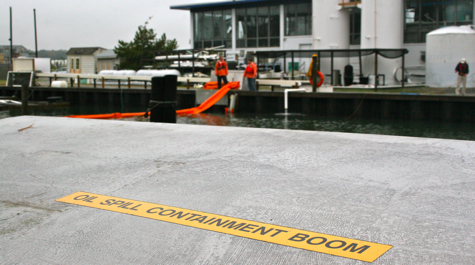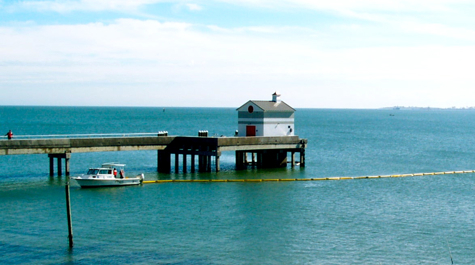VIMS helps bring science to Gulf spill
Researchers with the Virginia Institute of Marine Science in Gloucester Point recently traveled to Louisiana to help craft the nation's immediate and long-term scientific responses to the Gulf oil spill.
Professor Carl Hobbs represented VIMS in the Deepwater Horizon Oil Spill Scientific Symposium, which was hosted in Baton Rouge by the Consortium for Ocean Leadership. COL represents the nation's leading ocean research and education institutions, aquaria, and marine industries.
VIMS Dean and Director John Wells took part in the State of the Coast Conference and the quarterly meeting of the Louisiana Coastal Area Ecosystem Restoration and Protection Program (LCA); both of these previously scheduled meetings included special sessions on developing strategies to place the spill and its impacts within the broader, ongoing goal of restoring the area's coastal wetlands. Wells has served on the LCA Science Board since 2006.
Graduates of William and Mary's School of Marine Science at VIMS are also playing a leading role in the scientific response to the Gulf spill. Don Boesch (Ph.D. '71), president of the University of Maryland Center for Environmental Science, was recently named to President Obama's national oil spill commission. Irving Mendelssohn (M.A. '73), a professor at Louisiana State University, has been a leading scientific voice concerning the spill's impact on salt marshes in the Gulf, and co-led the special session at the State of the Coast Conference. Michael Carron (M.A. '76, Ph.D. ‘79) is Director of Mississippi State University's Northern Gulf Institute and led one of the working group sessions at the COL symposium.
Wells notes that VIMS' primary role in regards to oil spills is to provide the scientific expertise needed to track, model, and assess a spill and its ecological impacts. "Although we aren't mandated as a response agency in the current spill," he adds, "we will certainly provide any reasonable service if asked." VIMS researchers have developed computer models that can be used to predict a spill's likely path, and can perform field and laboratory tests to quickly identify a spill's chemical "fingerprint." They also bring the ability to identify and monitor oil's acute and chronic effects on marine organisms and communities.
Developing the Scientific Response
The goal of the COL symposium was to identify how the U.S. science community can best fill the information gaps needed to determine the magnitude of the spill, assess and monitor the fate and transport of the oil and dispersants, and gauge the impacts of these substances on marine ecosystems and human communities.
Robert Gagosian, COL President & CEO, says "As the efforts continue in the Gulf of Mexico oil spill, we need to ensure that we bring the full capabilities of the nation's research community to deal with the short-term and long-term impacts of this incident."
Hobbs, a marine geologist who has worked with federal and state agencies since the late 1970s to develop and test Virginia's own oil-spill response plan, joined the working group that focused on monitoring and predicting the movement and weathering of the spilled oil.
Hobbs says "There was consensus among our group that very small amounts of highly weathered oil might reach the Outer Banks, but that any ecological impacts to the shoreline would be far less severe than in the Gulf." He says the odds of oil entering Chesapeake Bay are low.
Hobbs notes that one of the many challenges that scientists face is to develop the "chemical fingerprint" that would allow them to track oil from the Gulf spill and distinguish it from other hydrocarbons in the water. Another challenge is to ensure that researchers from different agencies and institutions follow the monitoring and assessment protocols set forth in EPA's Natural Resource Damage Assessment process. The federal government uses the process to calculate the cost of restoring natural resources impacted by oil spills and other hazardous releases.
"In order to inform possible legal proceedings," says Hobbs, "lab and field studies of the spill and its effects must be conducted in a standardized way, and any collected samples or data must follow a formal chain of custody."
Wells, a professor at LSU from 1979 to1984, stresses that the response to the current spill should recognize the many other environmental challenges facing the region, and the long-term strategies and goals developed during the last decade to help protect and restore the Mississippi Delta and surrounding coastal areas.
"In addition to the current spill," says Wells, "the Delta region is challenged by rising sea levels, land subsidence, decreasing sediment supplies, low-oxygen dead zones, large-scale dredging operations, and—as we saw so clearly in 2005 with Katrina and Rita—hurricanes. Scientific input is critical to informing an effective and sustainable response to all these challenges."
Partnering with Federal Agencies
During the LCA session, both the National Oceanic and Atmospheric Administration and National Science Foundation laid out their current actions and future plans to bring science to spill response and recovery.
NOAA is providing scientific support to the Coast Guard, which is designated in the Oil Pollution Act of 1990 as the "Federal On-Scene Coordinator" for oil-spill response actions in the U.S. Among many other functions, NOAA ships and scientists are responsible for predicting oil movement and shoreline impacts, estimating oil flow rates, and evaluating impacts to sea turtles, marine mammals, and other organisms. As of the end of May, NOAA had four aircraft, two NOAA ships, and five contract ships active in the Gulf.
NSF, whose main mission is to fund basic research, is using its RAPID response mechanism to channel funds toward near-term research on the spill. To date, NSF has received more than 60 unsolicited proposals from scientists and engineers at U.S. academic institutions wanting to launch or continue research in the Gulf of Mexico. Three NSF-supported science teams are already shipboard in the region, with another 7 cruises scheduled between now and early September.
"VIMS researchers are actively pursuing these research grants in order to bring their expertise to bear on the situation," says Wells. "Even though the spill isn't in our backyard, we should and do care about using marine science to help respond and recover from this disaster. Even if the oil never gets near Virginia, it will still impact our aquaculture industries and watermen by disrupting the supply of Gulf oysters and crabs to local seafood processors, and by affecting the market prices offered for local seafood."




